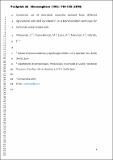Por favor, use este identificador para citar o enlazar a este item:
http://hdl.handle.net/10261/157352COMPARTIR / EXPORTAR:
 SHARE SHARE
 CORE
BASE CORE
BASE
|
|
| Visualizar otros formatos: MARC | Dublin Core | RDF | ORE | MODS | METS | DIDL | DATACITE | |

| Título: | Combined use of microbial consortia isolated from different agricultural soils and cyclodextrin as a bioremediation technique for herbicide contaminated soils |
Autor: | Villaverde Capellán, J. CSIC ORCID ; Rubio Bellido, Marina CSIC; Lara Moreno, Alba CSIC ORCID; Merchán, F.; Morillo González, Esmeralda CSIC ORCID | Palabras clave: | Bioremediation Contaminated soil Cyclodextrin Diuron Microbial degrading consortia |
Fecha de publicación: | feb-2018 | Editor: | Elsevier | Citación: | Chemosphere (193): 118-125 (2018) | Resumen: | The phenylurea herbicide diuron is persistent in soil, water and groundwater and is considered to be a highly toxic molecule. The principal product of its biodegradation, 3,4-dichloroaniline, exhibits greater toxicity than diuron and is persistent in the environment. Five diuron degrading microbial consortia (C1[sbnd]C5), isolated from different agricultural soils, were investigated for diuron mineralization activity. The C2 consortium was able to mineralize 81.6% of the diuron in solution, while consortium C3 was only able to mineralize 22.9%. Isolated consortia were also tested in soil slurries and in all cases, except consortium C4, DT50 (the time required for the diuron concentration to decline to half of its initial value) was drastically reduced, from 700 days (non-inoculated control) to 546, 351, and 171 days for the consortia C5, C2, and C1, respectively. In order to test the effectiveness of the isolated consortium C1 in a more realistic scenario, soil diuron mineralization assays were performed under static conditions (40% of the soil water-holding capacity). A significant enhancement of diuron mineralization was observed after C1 inoculation, with 23.2% of the herbicide being mineralized in comparison to 13.1% for the control experiment. Hydroxypropyl-β-cyclodextrin, a biodegradable organic enhancer of pollutant bioavailability, used in combination with C1 bioaugmentation in static conditions, resulted in a significant decrease in the DT50 (214 days; 881 days, control experiment). To the best of our knowledge, this is the first report of the use of soil-isolated microbial consortia in combination with cyclodextrins proposed as a bioremediation technique for pesticide contaminated soils | Descripción: | 8 páginas.-- 5 figuras.-- 4 tablas.-- 52 referencias.-- Supplementary data related to this article can be found at https://doi.org/10.1016/j.chemosphere.2017.10.172 | Versión del editor: | https://doi.org/10.1016/j.chemosphere.2017.10.172 | URI: | http://hdl.handle.net/10261/157352 | DOI: | 10.1016/j.chemosphere.2017.10.172 | ISSN: | 0045-6535 | E-ISSN: | 1879-1298 |
| Aparece en las colecciones: | (IRNAS) Artículos |
Ficheros en este ítem:
| Fichero | Descripción | Tamaño | Formato | |
|---|---|---|---|---|
| Combined_microbial_consortia_2018_Postprint.pdf | 870,52 kB | Adobe PDF |  Visualizar/Abrir |
CORE Recommender
SCOPUSTM
Citations
38
checked on 09-abr-2024
WEB OF SCIENCETM
Citations
31
checked on 24-feb-2024
Page view(s)
447
checked on 24-abr-2024
Download(s)
330
checked on 24-abr-2024
Google ScholarTM
Check
Altmetric
Altmetric
Este item está licenciado bajo una Licencia Creative Commons

